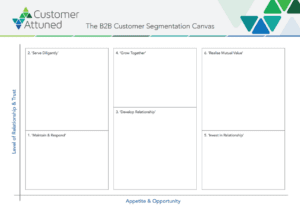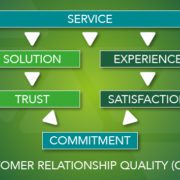B2B Customer Segmentation that Unlocks Potential Value
B2B Customer Segmentation that unlocks potential value
In B2B, most companies don’t need a segmentation model to know who their best customers or brokers are. They just need to look at their revenue figures. Sure, some customers may be “higher maintenance” than others, but at the end of the day the dollars speak for themselves.
In business models where “value” isn’t just money, e.g. not-for-profits or industry associations, account managers will intuitively know their best customers, and there will be other measures that proxy for value e.g. engagement or advocacy.
Growth plans are often oriented towards new markets, channels and products, plus winning business from competitors. This is the “front door”. But what about customers already on the premises? Who’s keeping an eye on the “back door” i.e. are your new customer acquisitions just replacing attrition or market stagnation elsewhere?
A customer centric growth plan will of course include markets, channels and products, but will also explicitly address the key drivers of customer value growth:
- Existing customer retention (renewals, contract extensions, like-for-like replacements, etc.)
- Existing customer penetration (deepening the relationship through cross-sell, up-sell and opening up business with extra divisions or regions within existing clients)
- Managing the costs to acquire and serve (improving the efficiency of how you sell and service without compromising trust or the customer experience)
- And, of course, new (good) customer acquisition (plus don’t forget winning back lost customers)
A key challenge for all types of B2B companies is to find and nurture the accounts who, together with you, are going to be the best customers of the future and thereby fuel your growth. This means identifying and engaging with the customers who both see and want the benefits of a deeper relationship. Equally important is knowing who to leave alone!
At Customer Attuned we believe that’s where effective customer segmentation comes in – it’s all about realising the untapped potential value in B2B relationships.
A New Approach to Customer Segmentation
This is why we, at Customer Attuned, have introduced a new approach to segmenting B2B customers.
Called the Customer Segmentation Canvas, it is a toolkit of assets that are free to use to start building or developing your own B2B customer segmentation model so that you can better identify and manage the relationships that are going to power your growth.
It is based on proven academic research and decades of experience delivering customer management programmes for clients. It works on two axes that are wholly distinct from traditional approaches to B2B segmentation.
 The vertical axis is all about the level of relationship and trust that has or hasn’t been established. Long-standing customers with lots of your products who see you as trusted advisors will be at the top, and new customers with perhaps just one product who are ‘checking you out’ will be at the bottom.
The vertical axis is all about the level of relationship and trust that has or hasn’t been established. Long-standing customers with lots of your products who see you as trusted advisors will be at the top, and new customers with perhaps just one product who are ‘checking you out’ will be at the bottom.
The horizontal axis addresses whether there’s any opportunity to grow the relationship, and – crucially – if there’s appetite to do so.
On the left there is either no opportunity or no appetite; on the right both are in abundance!
Making Customer Segmentation Real
Knowing where customers sit in a segmentation framework is only the first step! Your customer management plans and treatments will then need to be accordingly developed and applied to maintain and grow your best customers of the future.
We can assist with the full implementation of this new approach into your business. We are experts in B2B Customer Management and Organisational Performance improvement.
Check out the model and its resources and, if you need help segmenting at scale or implementing it within your CRM for systematic segmentation, the Customer Attuned team would be delighted to get involved.
Talk to us
Set up a call to discuss segmentation
Download the workbook and blank canvas here by clicking on the icons below:
- The Partner Relationship Survey – How it works - July 10, 2024
- Customer Centricity Corner with Peter Lavers – Partner Relationship Survey - June 26, 2024
- Customer Centricity Corner with Peter Lavers – Account Based Marketing - May 30, 2024





